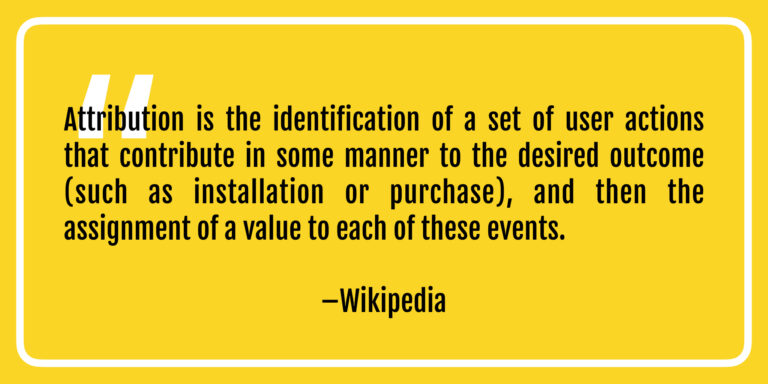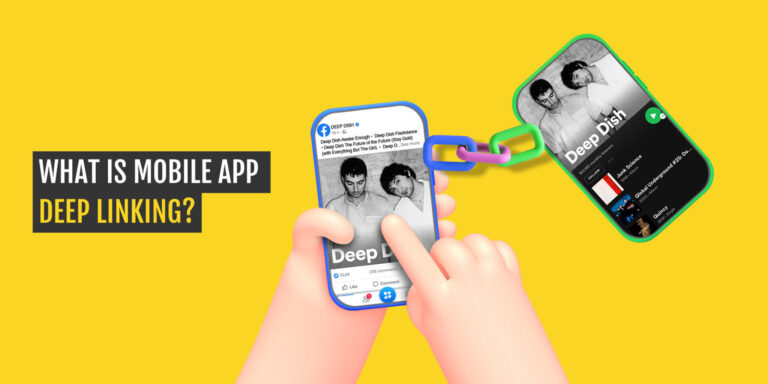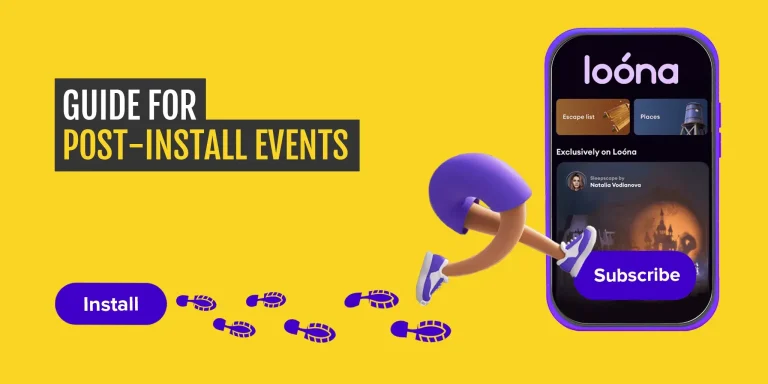To learn more about industry insights and best practices, sign up for the AppAgent newsletter here.
Why it’s impossible to effectively grow your app or game with mobile ads without having attribution tracking in place? Continue reading.
It doesn’t matter if you’re a mobile startup or an established publisher with a new app or game, sooner or later you’ll reach a point when you need to measure the effectiveness of your user acquisition campaigns. This stage usually arrives when you begin to extend your acquisition efforts, or expand outside of a single platform such as Facebook or Google Ads.
In this article, we have included the most important information that you need to know about mobile app attribution. By following it you can track how every dollar you spend is growing your mobile app faster.
In it you will learn:
- How web and mobile attribution differs, and why you need to work with specialists.
- What the common attribution models are, and the differences between them.
- A step-by-step explanation of how mobile attribution works.
- Technical methods you can use to measure mobile app attribution.
- The best mobile attribution tools on the market.
What is Mobile Attribution and Why Is It Critical in 2025?
Mobile ad attribution is the process of identifying which marketing channel, campaign, or creative led to a specific app install or in-app event. It helps answer the question: Which ad worked, and where should I reinvest my budget?
Without it, you’re essentially flying blind — unable to scale campaigns, measure ROAS, or identify the channels delivering high-LTV users.
Attribution is especially essential today, where privacy changes (like ATT) and multi-channel acquisition make tracking user journeys far more complex than a decade ago.
Why traditional web attribution doesn’t work for mobile
By definition, mobile ad attribution is the same as web attribution.

The principles may be the same, but mobile attribution is far more complex than the online advertising world, where there are established and verified methods for tracking a user through their internet journey. This is achieved online through using cookies (which can now more easily be restricted by the user), image pixel tags, and appending custom parameters to the URL, such as UTM Parameters.
On mobile, it’s much more difficult to track the whole journey, mostly because user identification is lost as users move between the store and the actual install. For this simple reason, attribution on mobile works on very different principles which we will explore below.
What are the five common mobile attribution models
First, let’s talk about commonly used attribution models. It’s important, because it will have an influence on your selection of attribution platform. It’s also good to understand differences in models which can have a fundamental impact on the evaluation of your campaigns.
Basically, there are two types of model: a single attribution method, and multi-touch attribution which takes into consideration assisted touch-points. As Appsflyer explains: “In many cases, potential users get familiar with an app via the assisting source, but fail to install for some reason. When these users are exposed to the same app via another source they are already convinced to download, and just needed a reminder. Without the assists, these potential users would probably have not become real users.”

Single-touch models:
- Last Click. This is the most frequently used model, with the conversion attributed to the last click on an advertisement made by the user.
- First Click. In this model, only the first click on an ad is counted. It’s used predominantly for measuring brand awareness, which isn’t so common in the performance-driven mobile marketing world.
Multi-touch models:
- Linear. Every click is counted as equal, with all receiving an attribution.
- Position-based. Both the first and the last click receive attribution, with any clicks between them not considered.
- Time Decay. The closer it gets to the last click (conversion itself), the higher the percentage of the attribution.

Why Multi-Touch Attribution Matters
App users don’t convert instantly. They may scroll past an Instagram Story, see a TikTok ad the next day, and finally click a Google UAC ad. Without multi-touch attribution, that entire journey is ignored — and you may underinvest in high-performing assisting channels.
AppsFlyer reported that 23% of users interact with multiple touchpoints. Without capturing those assists, you risk misattributing your most important conversions.
How to tune mobile attribution window
Whether the install is attributed to the last network the user interacted with — or is completely lost — depends on how many days elapse between a click on an ad and the initial launch of the app after installation. This is the attribution window, and each ad network has its own default:
Facebook: 28 days
Google Ads: 30 days
Twitter: 14 days
View-Through Attribution (VTA):
Some installs happen after a user views an ad but doesn’t click. VTA assigns credit to these “impression-only” touchpoints and usually operates within a 24-hour window.
If you want apples-to-apples numbers between your ad networks and attribution dashboard, make sure your windows are aligned.
Another scenario that you may experience is a user having seen your ad, but having installed the app without clicking on it. It’s called view-through attribution and has a much shorter window than the attribution window, in most cases of just one day. The credit for the install here goes to the last ad serving network.
How actually mobile ad attribution works
While this is quite a technical topic, the principle of the mobile attribution isn’t rocket science and can be explained simply in the following five steps:

1/ A user clicks on an ad (on Facebook, Unity Ads etc.) and is redirected to the appropriate app store.
2/ After clicking the „Download“ button, the installation is counted in the app store. On the Android platform, you can see the installation source in Google Analytics (GA) using the Google referral line. However, this method – by using Google Analytics – is not able to send a postback call (=information snippet) to any ad network to exclude the user from showing ads for your app after the install happened. Therefore, even having an Android app only, using GA for attribution here isn’t the best solution.
3/ In both cases – on Android and iOS – where mobile attribution platforms are coming to the scene, to track the source of install an SDK has to be implemented within the app. Right after the app is opened for the first time, an SDK immediately asks all ad networks: “Hey, do you know anything about this IDFA / Google Advertising ID?†(or any other identifier we’re mentioning below) and waits for an answer. At this stage, it depends on which attribution model is chosen and how the attribution windows are set up in determine to whom the attribution will be assigned.
4/ After pairing an ID with an ad network, an attribution SDK sends a postback to all linked networks with the information that the user has already installed the app.
Methods for Measuring Mobile App Attribution
Since apps don’t support traditional tracking methods such as cookies, other means are needed to technically pair a user clicking on an ad with a new install. Also, UA managers measure additional activities within that app to evaluate the quality of the traffic, including whether a user has finished onboarding or completed a purchase.
Right now, there is no industry standard for the best methodology for measurement, but some methods have become universal. Even today, you won’t come across these methods if you are using any attribution tool (eg. Appsflyer), as it’s automated. However, I feel it’s still useful to know about them.
Unique Identifier Matching: These are click-to-install comparisons in real-time, based on GAID (Google Play) or IDFA (App Store).
Device Fingerprinting: This method works by collecting publicly available data on a mobile device, which then creates a unique fingerprint. It’s used for the further attribution of an app install to a certain channel.
Open URL with Click ID: Users create a unique Tracking ID as soon as they click on advert which is then turned into a conversion request for an install. The conversion to the advertisement source is then associated with the click to the advertisement source.
Unified Attribution Solution: This integrates various methods of a mobile app download tracking. This creates a unified solution for attributing app-to-app installs and mobile web-to-app installs
Privacy-Safe Attribution (2025 Update)
SKAdNetwork on iOS and Android’s Privacy Sandbox mean deterministic matching is limited. Attribution platforms now rely on:
Aggregated conversion values
Predictive modeling
Event postbacks with delays
The best mobile attribution platforms on the market
To make life easier for mobile marketers, there are several attribution analytics, which can take care of the entire mobile attribution 3-step process. They can:
- measure the initial click;
- attribute the click to install; and
- notify partners of installs and events through server postback URLs.
The major attribution platforms are Appsflyer, Adjust, Kochava. The newest player is Branch which became FB MMP in late August this year, and shortly after that announced an acquisition of Tune.

Choosing the Right Attribution Partner for Your App
If you’re running user acquisition across multiple ad networks and platforms, choose a partner that offers:
SKAdNetwork support
Customizable attribution windows
Cross-platform tracking (web > app)
Fraud prevention tools
Real-time postbacks

This is all we have time for today, but you can read more about the pros and cons, pricing and other important information on mobile attribution in the second part of this article.
Written by Vit Volsicka and Peter Fodor









